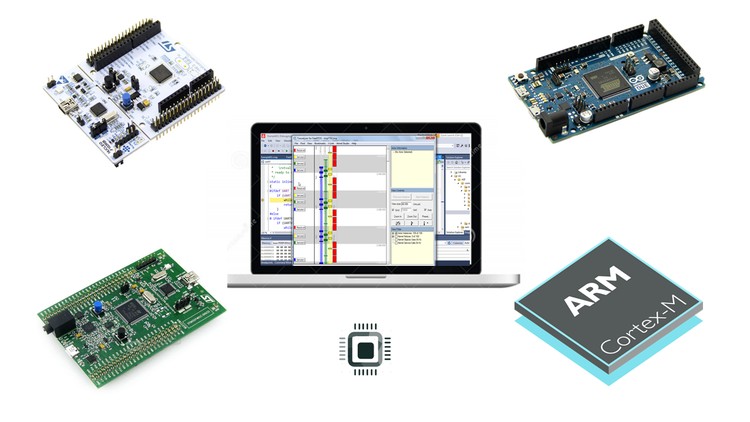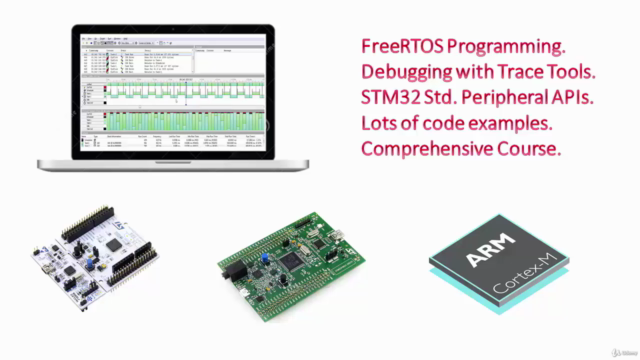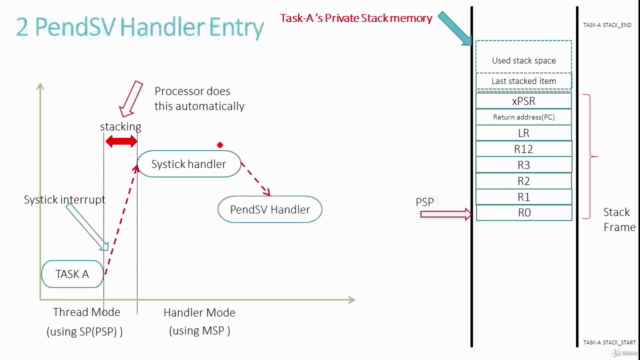Mastering RTOS: Hands on FreeRTOS and STM32Fx with Debugging

Why take this course?
🌟 >>> The Complete FreeRTOS Course with Programming and Debugging <<< 🌟
Course Update: 🚀
- Latest update includes RTOS debugging using SEGGER SystemView Trace tools, STM32 HAL, Peripheral APIs, and more examples for a comprehensive learning experience.
- Subtitles (CCs) and transcripts available for this course to aid your learning.
- Dedicated Support team to answer all your Questions/A (Q/As).
Course Overview: The primary goal of this course is to demystify RTOS practicality using FreeRTOS on STM32 Microcontrollers (MCUs). It's designed for beginners to advanced learners and provides a STEP-by-STEP guide to port/run FreeRTOS using a development setup that includes:
- STM32CUBEIDE + STM32F4xx + FreeRTOS + SEGGER SystemView
Architecture and Code Demystified: This course delves into the complete architecture (ARM Cortex M) related code of FreeRTOS, which will enable you to port this kernel onto any target hardware of your choice.
Development Board Used:
- If you have an existing STM32-based development board, feel free to use it. The course is based on the STM32F407G-DISC1 board.
Software Used:
- STM32CUBEIDE (cross-platform compatible with WIN/OSX/LINUX) - free to use.
- SEGGER SystemView software (free edition).
Operating Systems Compatibility: The course is compatible with WIN/MAC/UBUNTU.
Debugging FreeRTOS with SEGGER SYSVIEW: This course includes extensive guidance on debugging FreeRTOS using SEGGER SystemView software. Be sure to watch the preview videos for a clearer understanding of this process.
Embedded Debugging and Quizzes: Mastering embedded debugging is crucial, and this course covers various debugging techniques and features essential for a deep understanding of the field. Additionally, there are quizzes to test your knowledge!
My Promise: I am fully committed to assisting you with any questions about this material, whether privately or in group discussions. Your satisfaction is my priority. If you're unsatisfied for any reason within 30 days of purchase, you can get a full refund from Udemy without any questions asked.
Learning Order of FastBit Embedded Brain Academy Courses: For beginners in the field of embedded systems, I recommend taking the courses in this order for a structured learning path:
- Microcontroller Embedded C Programming: absolute beginners (Embedded C)
- Embedded Systems Programming on ARM Cortex-M3/M4 Processor (ARM Cortex M4 Processor specific)
- Mastering Microcontroller with Embedded Driver Development (MCU1)
- Mastering Microcontroller: TIMERS, PWM, CAN, RTC, LOW POWER (MCU2)
- Mastering Microcontroller: STM32-LTDC, LCD-TFT, LVGL (MCU3)
- Embedded System Design using UML State Machines (State machine)
- Mastering RTOS: Hands-on FreeRTOS and STM32Fx with Debugging (RTOS - This Course!)
- ARM Cortex M Microcontroller DMA Programming Demystified (DMA)
- STM32Fx Microcontroller Custom Bootloader Development (Bootloader)
- Embedded Linux Step by Step using Beaglebone Black (Linux)
- Linux Device Driver Programming Using Beaglebone Black (LDD1)
Embark on your journey to mastering Real-Time Operating Systems (RTOS) with FreeRTOS on STM32 Microcontrollers today! 🤖🚀
Course Gallery




Loading charts...
Comidoc Review
Our Verdict
Mastering RTOS: Hands-on FreeRTOS and STM32Fx with Debugging offers in-depth knowledge of the FreeRTOS real-time operating system, its application on STM32 microcontrollers using OpenSTM32 System Workbench, and ARM Cortex M priority models. The course's main strength lies in its broad range of topics complemented by plenty of exercises. However, some drawbacks include difficulties following the fast pace and rapid cut/paste during video demonstrations, as well as occasional variations in audio quality. Overall, equipping students with valuable RTOS skills while leaving room for improvement in presentation style.
What We Liked
- Comprehensive coverage of FreeRTOS concepts, debugging, and implementation on STM32F4x microcontrollers using OpenSTM32 System Workbench
- Instructor's clear teaching approach and methodical presentation style, making it easy to follow and understand low-level RTOS functionality
- Comprehensive ARM Cortex M and FreeRTOS priority model explanation with detailed code analysis
- Complemented by a wide range of coding exercises, quizzes, and articles for in-depth learning
Potential Drawbacks
- Instructor's fast pace and lack of source code reference may cause confusion and hinder troubleshooting during hands-on sessions
- Limited examples of FreeRTOS' real-world use with CMSIS, leaving users to adapt the examples on their own
- The absence of context switching visualization or diagrams makes understanding complex synchronization problems challenging
- Some outdated content and occasional audio quality variations affecting learning experience